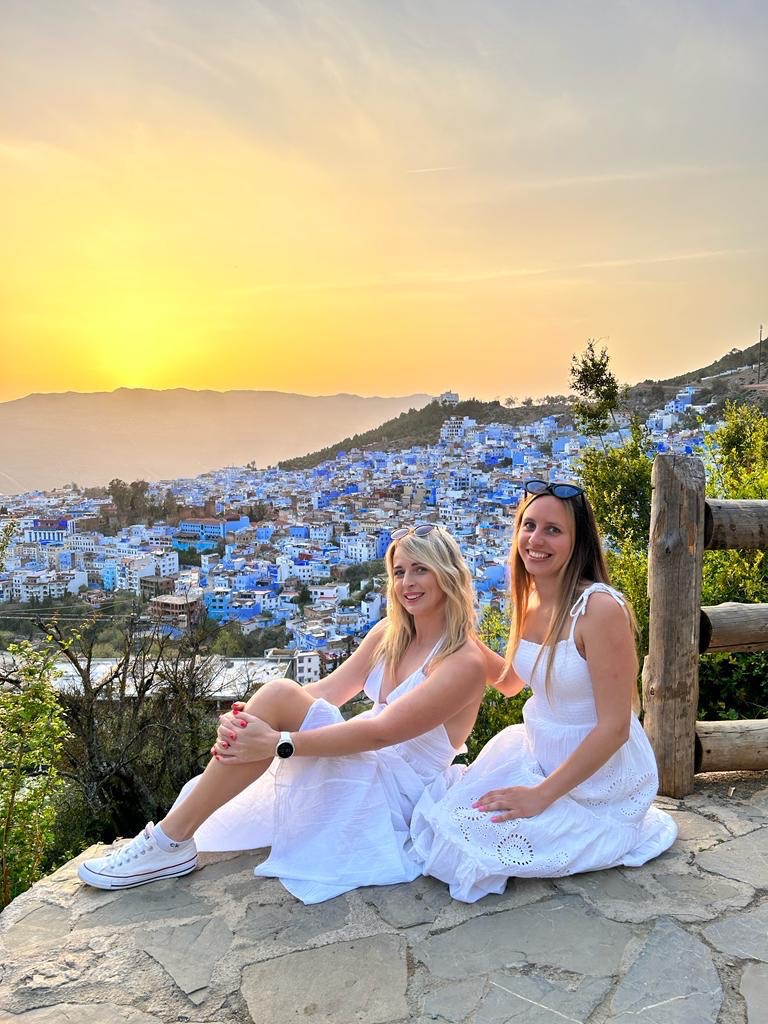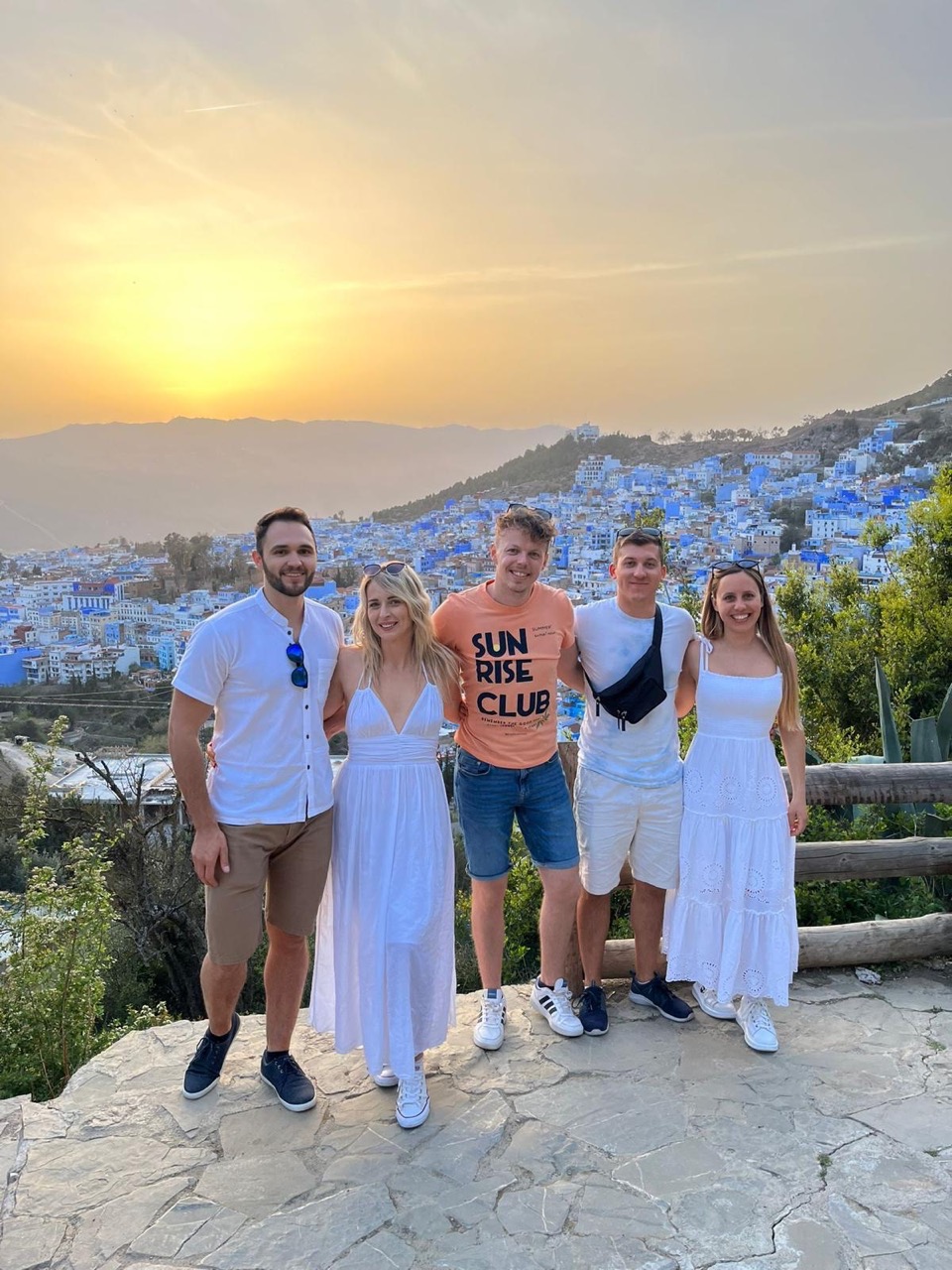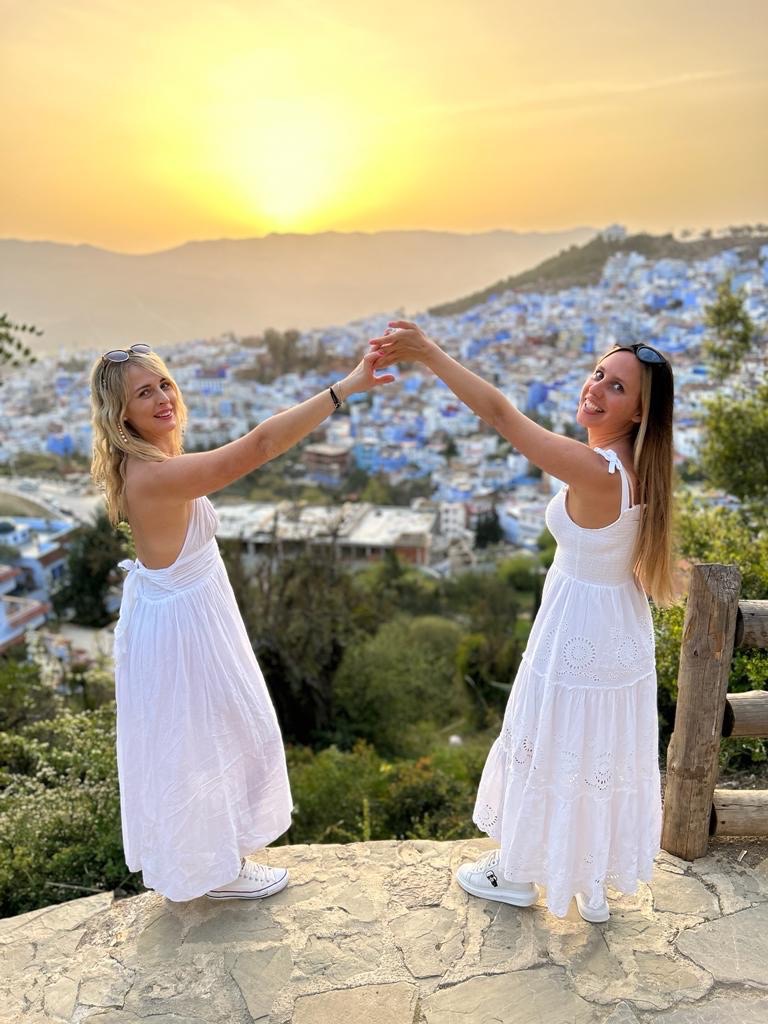Chefchaouen
I still remember the thrill of booking that Ryanair flight from Venice Treviso to Marrakech. For just around 40 euros, a steal really, the five of us were on our way to an adventure in Morocco. We were a mixed bunch, buzzing with excitement, our heads filled with images of bustling souks, exotic spices, and the legendary “Blue City” of Chefchaouen.
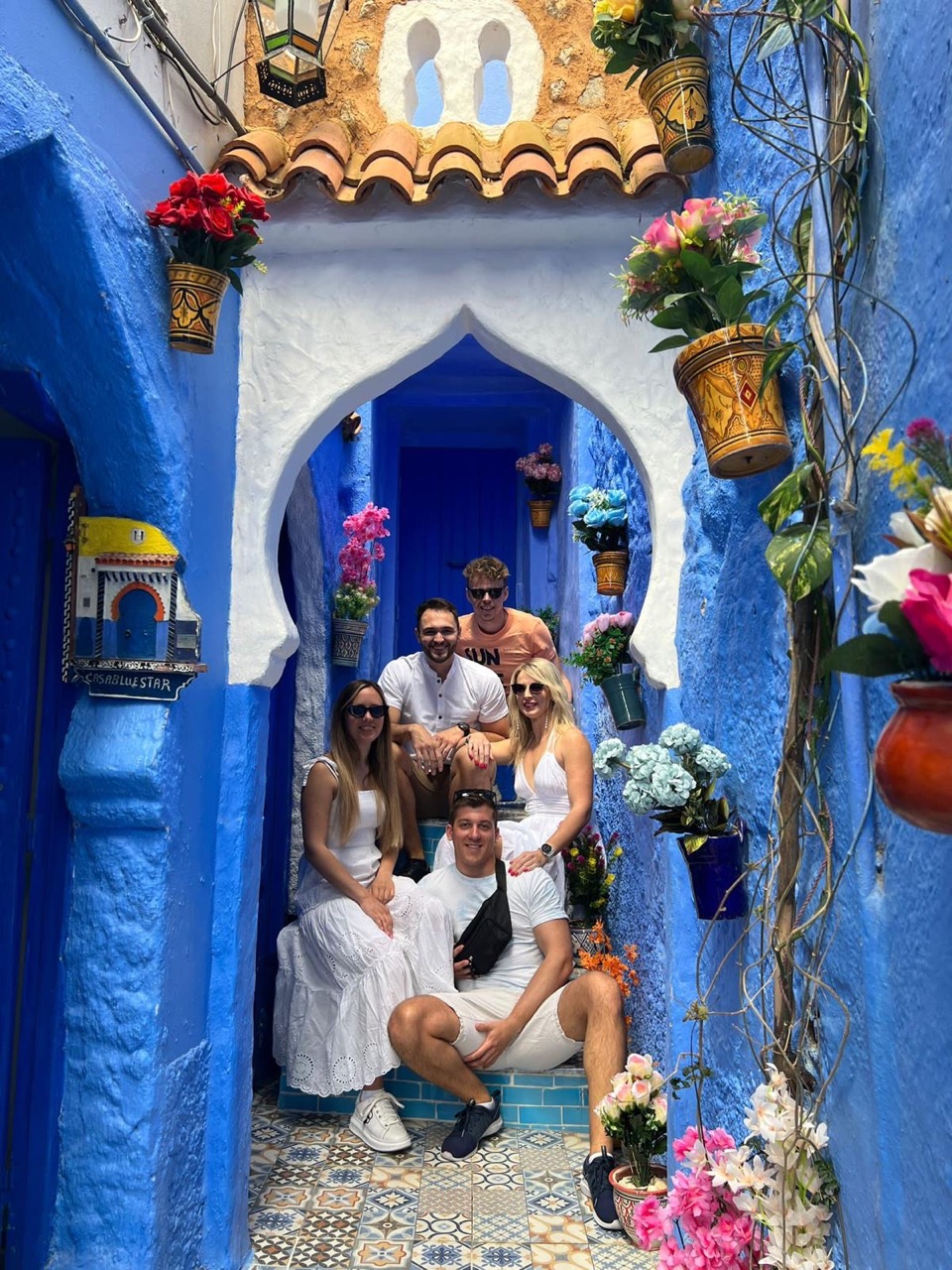
Little did we know that the real adventure, the kind that tests your patience and your friendships, would begin long before we saw a single blue wall. To get to our azure destination, we hired a car and a driver, a decision that would plunge us into one of the most memorable, and at times, genuinely terrifying, road trips of my life.
The Journey from Hell (But Worth Every Minute)
The journey from Marrakech to Chefchaouen is supposed to take around seven hours. I’d read it on blogs, seen it on maps. It seemed manageable. But Moroccan roads, we soon discovered, have a different sense of time.
Our driver, a friendly man with a mischievous glint in his eye, navigated the chaotic city traffic with an ease that was both impressive and alarming. Once we left the city limits, the landscape transformed into a vast, ochre-colored expanse, beautiful but monotonous.
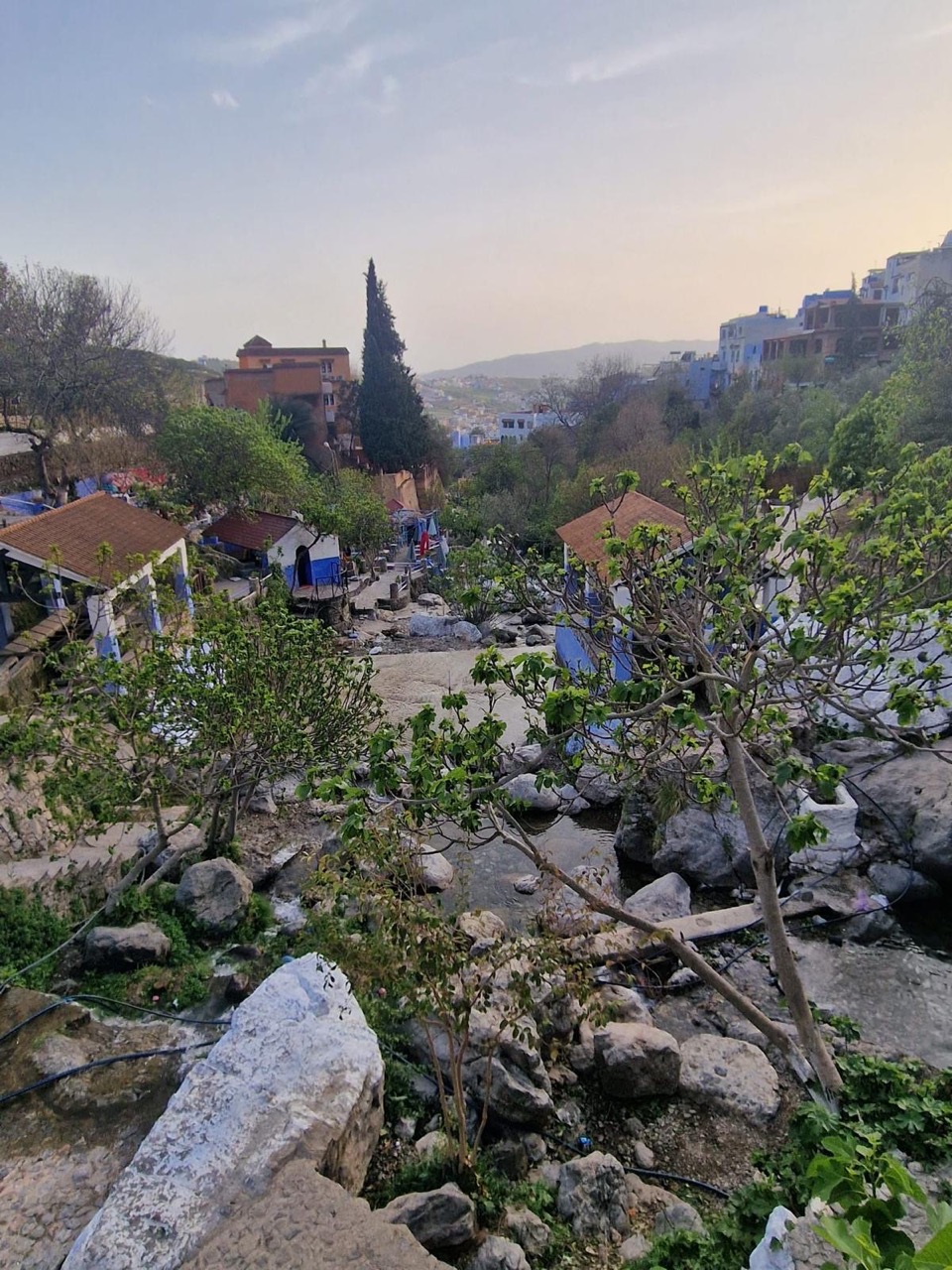
Every time someone in the back of our slightly-too-small rental car would pipe up with the inevitable question, “How much longer?” I’d dutifully consult Google Maps on my phone, the little blue dot moving at a glacial pace. With a forced, overly bright smile, I’d reply, “Just three more hours!” This became our mantra, a running joke that was funny the first time, less so the third, and by the fifth, it was just a grim statement of our perpetual state of being.
The Suspicious Checkpoint
The roads were nothing like the smooth highways we were accustomed to in Europe. They were winding, narrow, and pockmarked with potholes that sent us bouncing in our seats. We shared the road with everything from overloaded trucks to donkeys pulling carts, each encounter a new test of our driver’s skills and our nerves.
At one point, our driver, perhaps trying to find a shortcut or maybe just as lost as we felt, took a detour down a narrow, dusty alleyway that seemed to lead to nowhere. Suddenly, we were stopped at what looked like a makeshift checkpoint. Men in mismatched, unofficial-looking uniforms, brandishing an air of authority that didn’t quite sit right, surrounded our car and demanded our documents.
My blood ran cold. This wasn’t in the travel guide. My heart pounded in my chest, a frantic drum against my ribs. I clutched my bag, my passport safely inside, and refused to hand it over. The whole situation felt so deeply suspicious, so strange and unsettling.
Thankfully, one of my friends, braver or perhaps just more pragmatic than I, calmly took out his passport and showed it to the stern-faced man at his window. There was a tense moment of scrutiny, a muttered exchange in a language I didn’t understand, and then, with a dismissive wave, they let us pass.
First Glimpse of the Blue Pearl
But then, after what felt like a lifetime, we arrived. And in an instant, all the fear, the frustration, and the bone-deep exhaustion of the journey melted away. Chefchaouen, the Blue Pearl of Morocco, was everything I had imagined and so much more.
Nestled like a sapphire in the green folds of the majestic Rif Mountains, this small city of just over 46,000 people is a labyrinth of narrow, blue-washed streets that seem to lead you on a journey through a living painting. Founded in 1471 by Moulay Ali Ben Rachid as a fortress to defend against Portuguese invaders, Chefchaouen has a rich, layered history.
It has been a refuge for Andalusian Muslims, Moriscos, and Spanish and Portuguese Jews fleeing the Reconquista. This unique blend of cultures has created a palpable atmosphere of peace and artistry that you can feel in every corner of the city.
Why is Chefchaouen Blue?
This is the question on everyone’s lips when they first lay eyes on the city’s azure-tinted walls. The answer, it turns out, is as layered and fascinating as the city’s history. There isn’t one single reason, but rather a collection of theories, each adding to the mystique of the Blue Pearl.
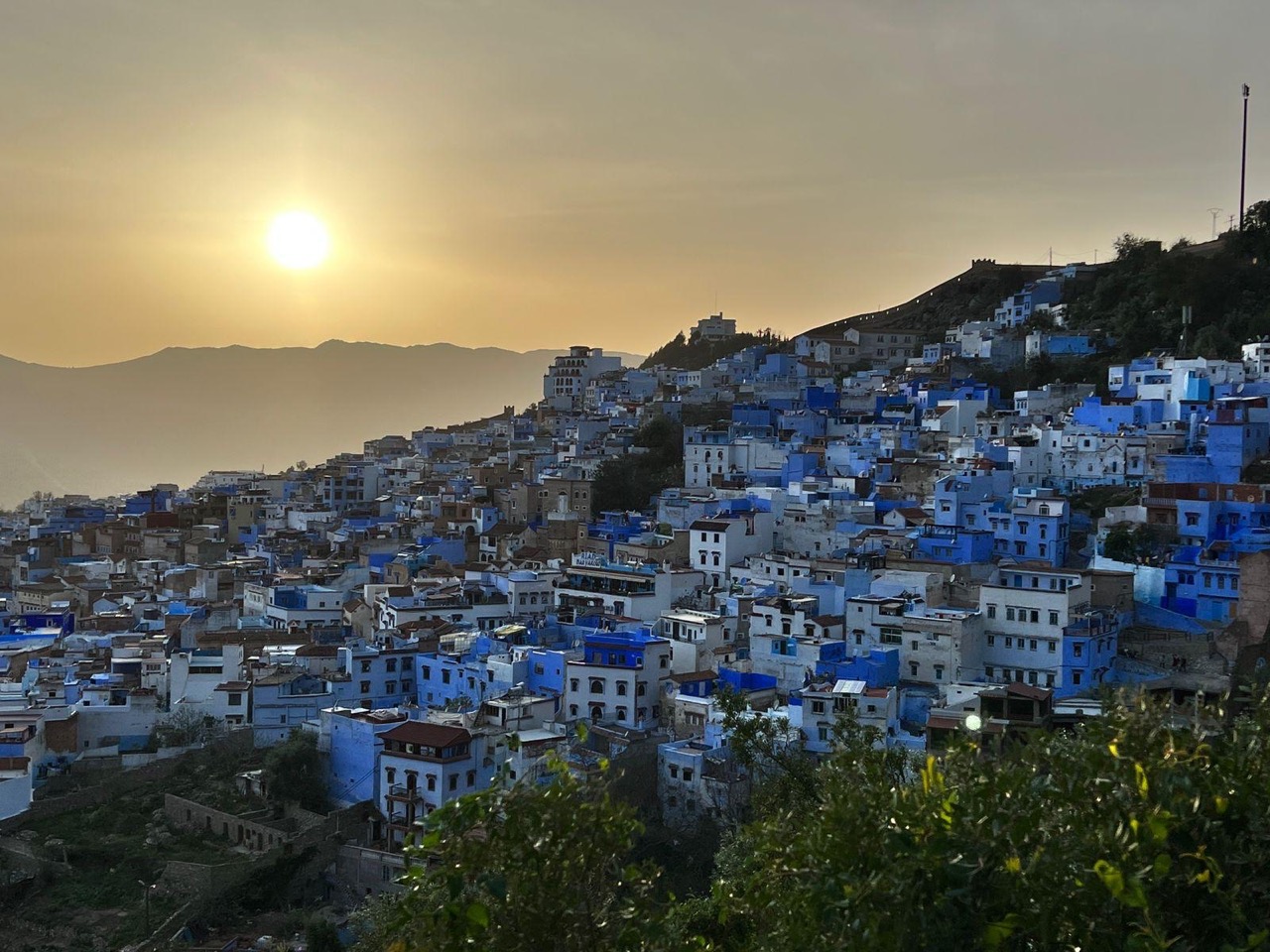
The Jewish Heritage Theory
One of the most widely cited beliefs is that the Jewish refugees who settled in Chefchaouen in the 1930s, fleeing the rising tide of antisemitism in Europe, painted their houses blue. For them, the color blue symbolized the sky and heaven, a constant reminder of God’s presence and a spiritual practice. This tradition, rooted in faith, is said to have been the genesis of the city’s iconic look.
The Practical Mosquito Theory
Another, more practical theory, suggests a more earthly purpose: the blue color repels mosquitoes. In a region where malaria was once a concern, this simple, aesthetic choice could have served as a form of community-wide pest control.
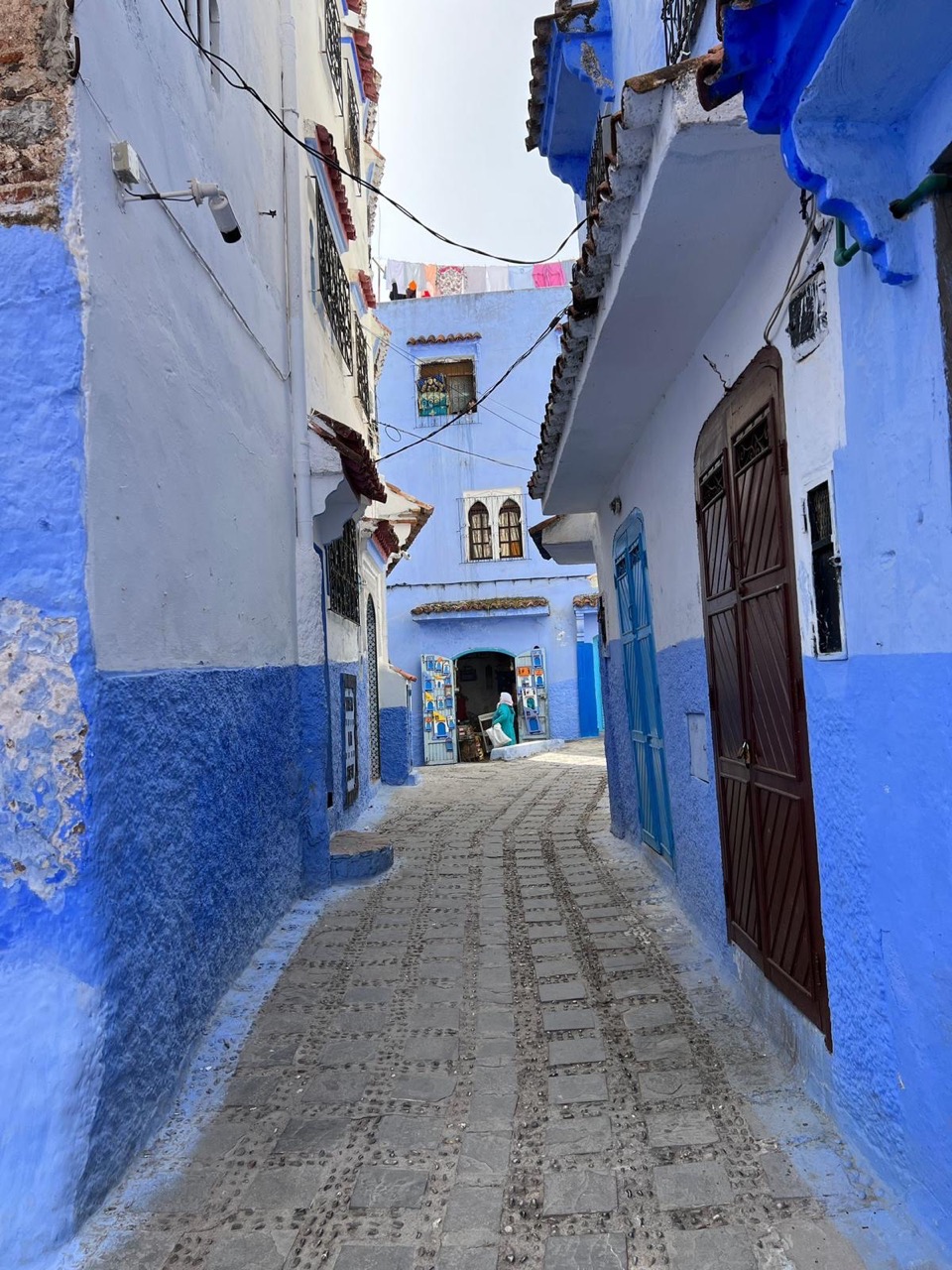
The Evil Eye Protection
Then there’s the traditional Moroccan belief that the color blue wards off the evil eye, protecting the homes and their inhabitants from misfortune. It’s a form of spiritual armor painted onto the very fabric of the city.
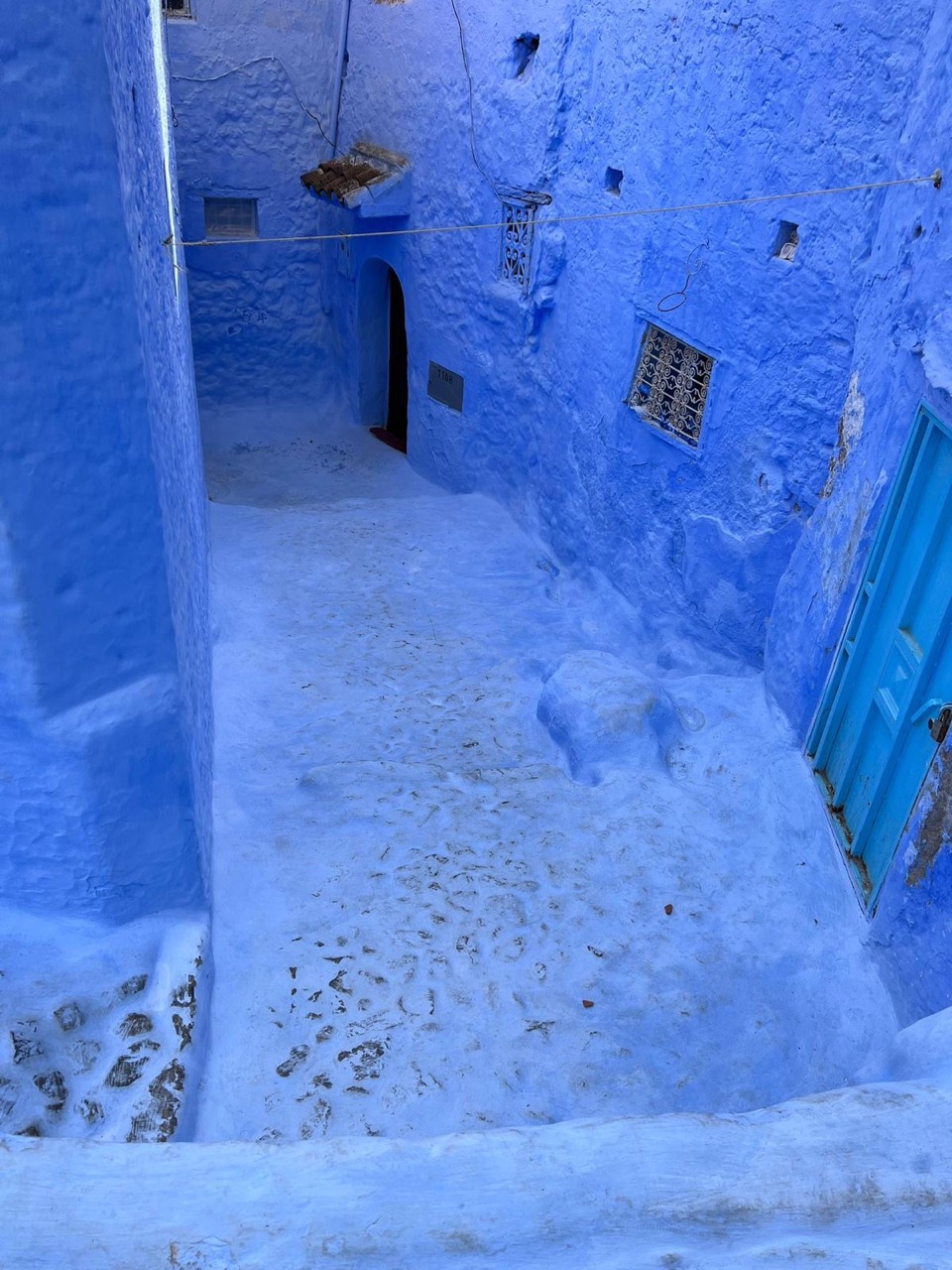
Today, while the original reasons may be debated, the tradition continues, in large part for the benefit of tourism. The residents of Chefchaouen take great pride in their city’s appearance, constantly refreshing the blue paint to maintain its vibrant, dreamlike quality.
Your One-Day Itinerary in Chefchaouen
Chefchaouen is a city best explored on foot, so put on your most comfortable shoes and get ready to lose yourself in its beauty. The medina is compact enough to navigate in a day, but be prepared for a workout – the city is built on a mountainside, and stairs are a way of life here!
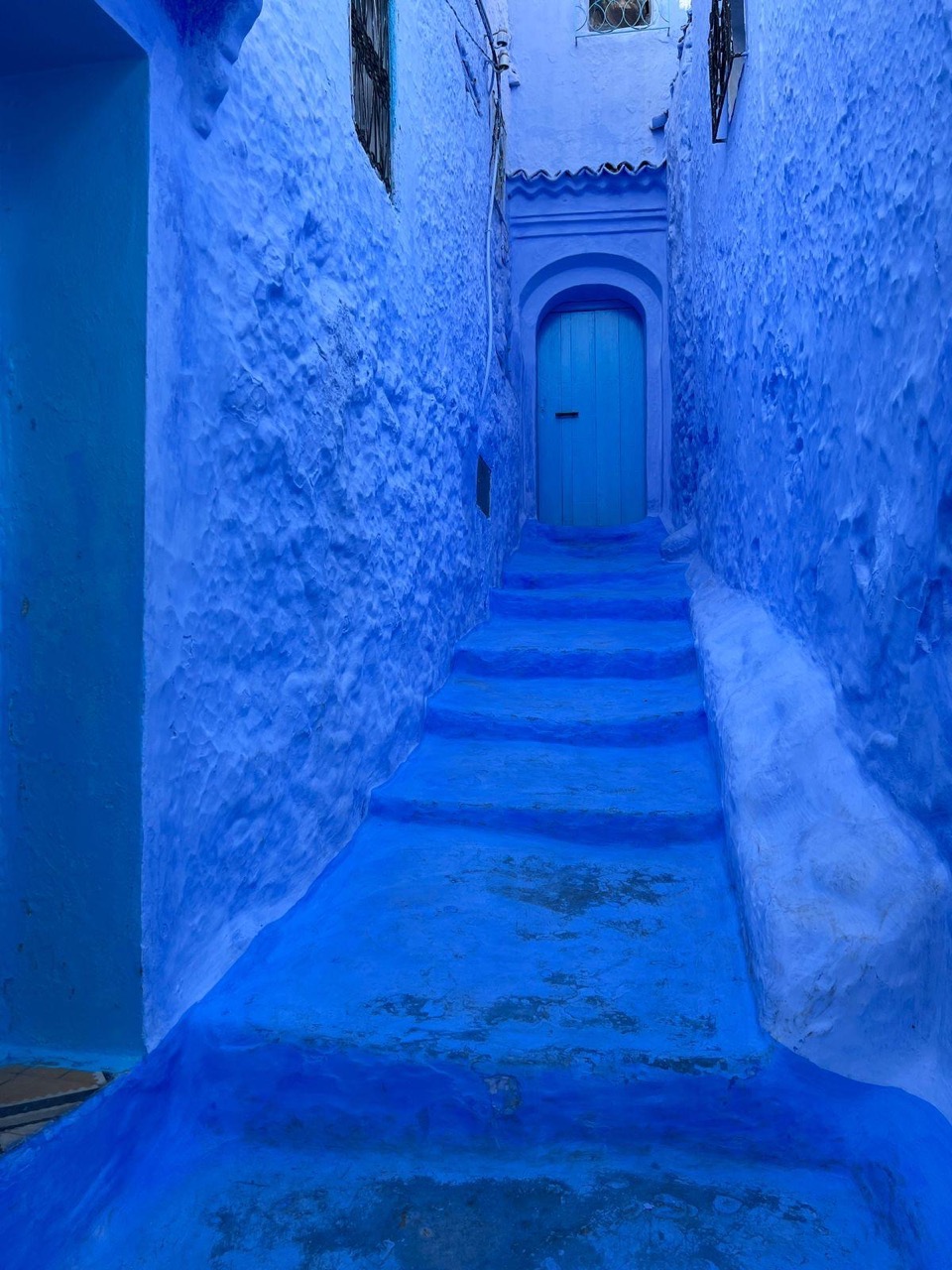
Early Morning: Get Lost in the Blue Medina (7:00 – 9:00 AM)
The absolute best way to start your day in Chefchaouen is to wake up with the sun. I’m talking early, around 7 or 8 a.m., and head straight into the labyrinthine streets of the medina. At this hour, the city is still sleepy and quiet, the air crisp and cool.
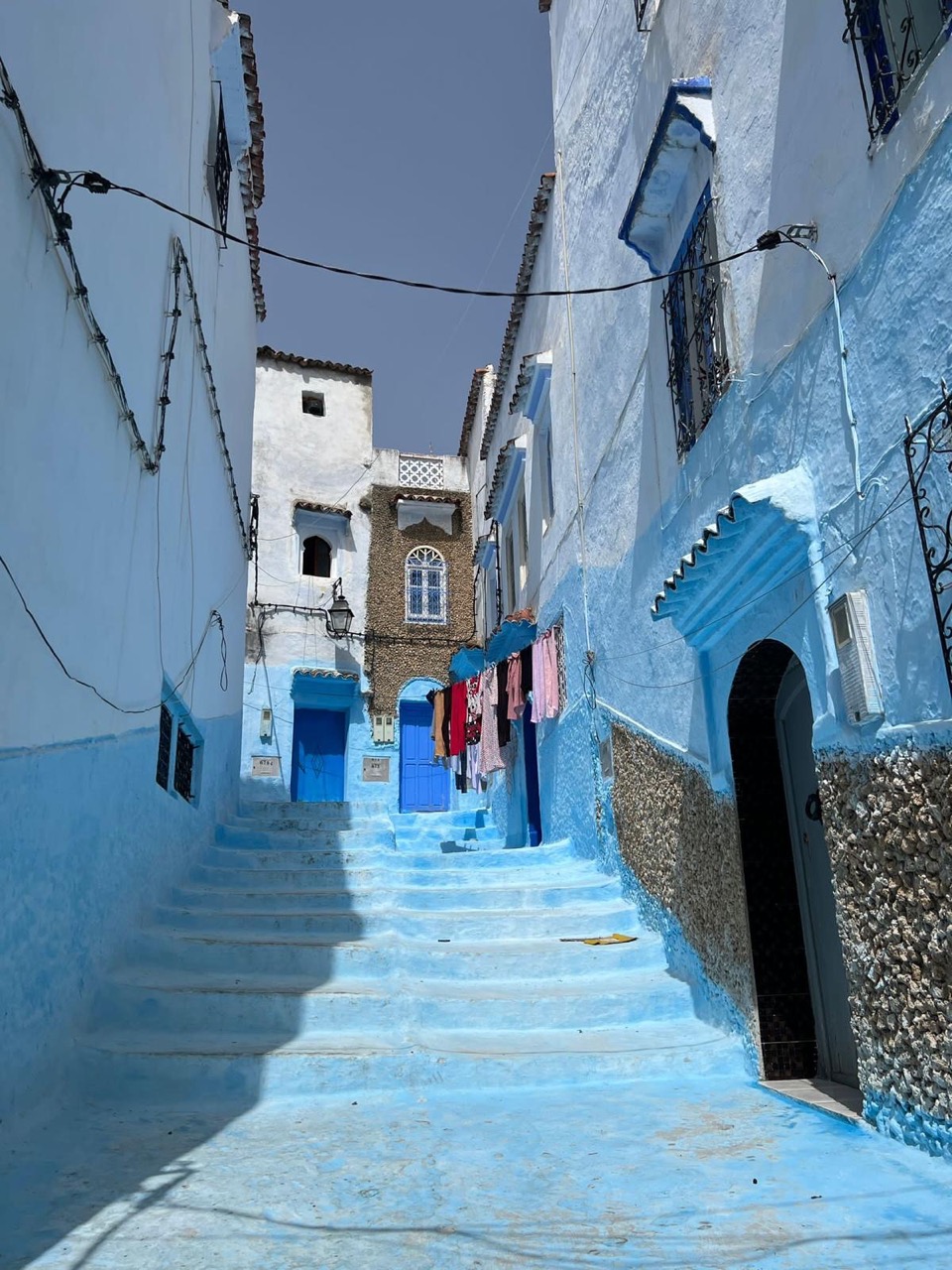
The day-trippers haven’t arrived yet, and you’ll have the magical, blue-washed alleyways almost to yourself. This is the golden hour for photography. The soft morning light casts a gentle, ethereal glow on the blue walls, creating a scene straight out of a fairytale.
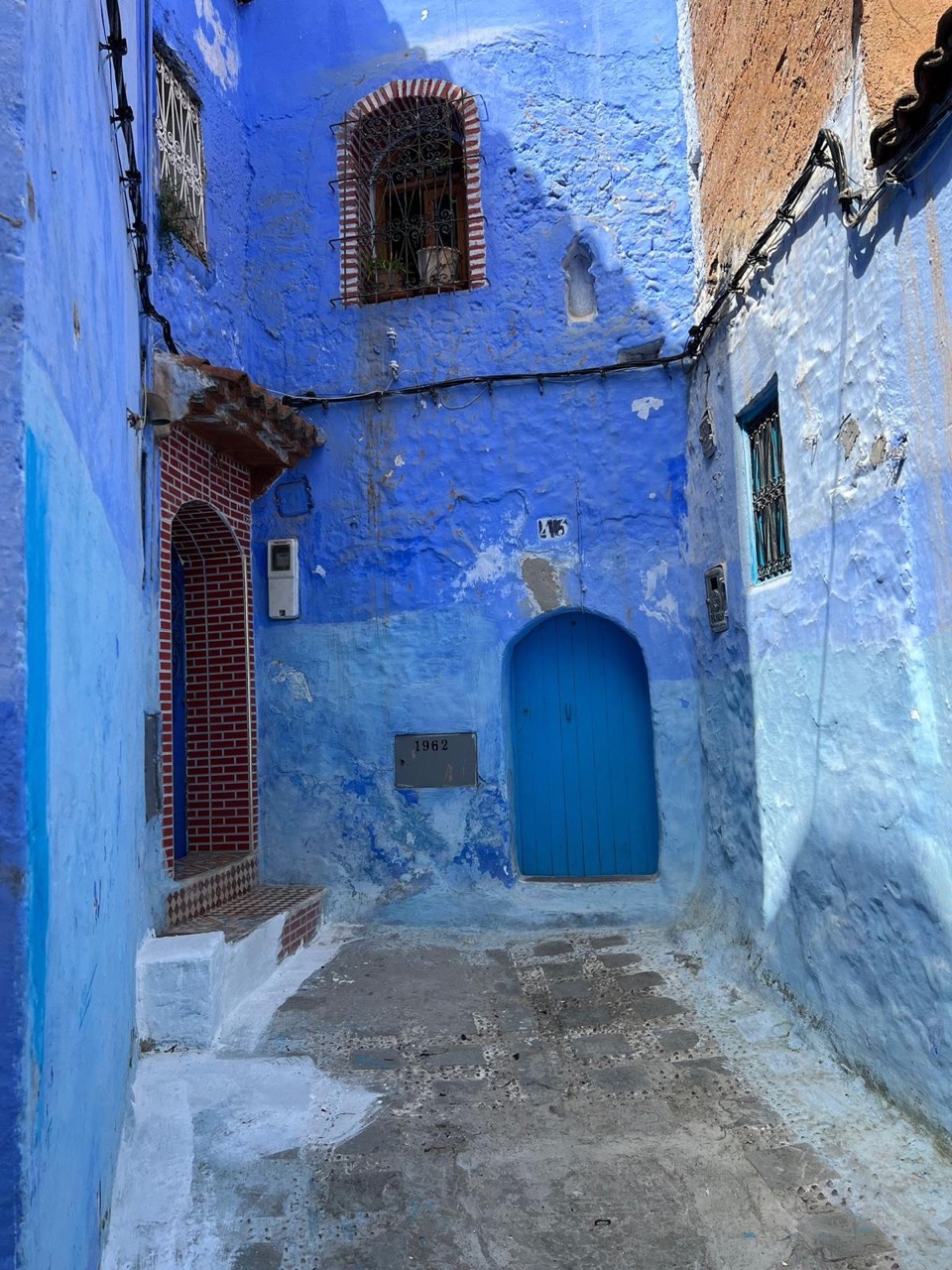
Pro tip: Wear white! The contrast with the vibrant blue walls will make your photos pop and give you that perfect, Instagram-worthy shot. But as you explore, remember to be respectful. This is not just a tourist attraction; it’s a living, breathing city where people make their homes.
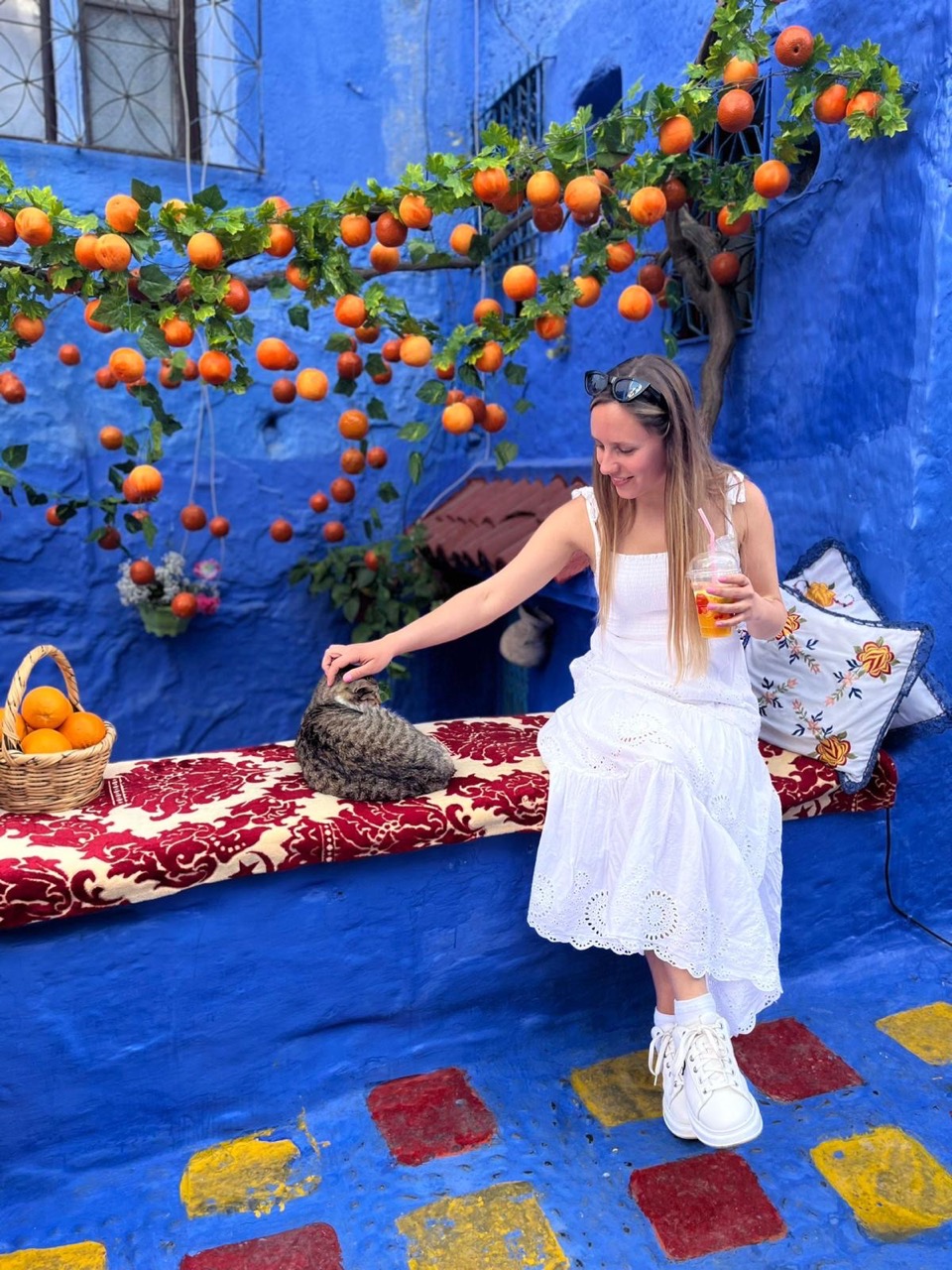
The Washing Machine Hose Incident
One of my most vivid and surreal memories from our trip was stumbling upon a washing machine hose sticking out of a wall in the middle of a street, cheerfully spewing water onto the ancient cobblestones. I just stood there, mesmerized, unable to comprehend the beautiful absurdity of it all. It was a perfect, quirky example of the city’s unique charm, a place where the mundane and the magical coexist in the most unexpected and delightful ways.
Mid-Morning: Breakfast on a Rooftop (9:00 – 10:30 AM)
After a morning of exploring and climbing countless stairs, it’s time for a well-deserved breakfast. And there’s no better way to enjoy it than on a rooftop terrace with a panoramic view of the city waking up below.
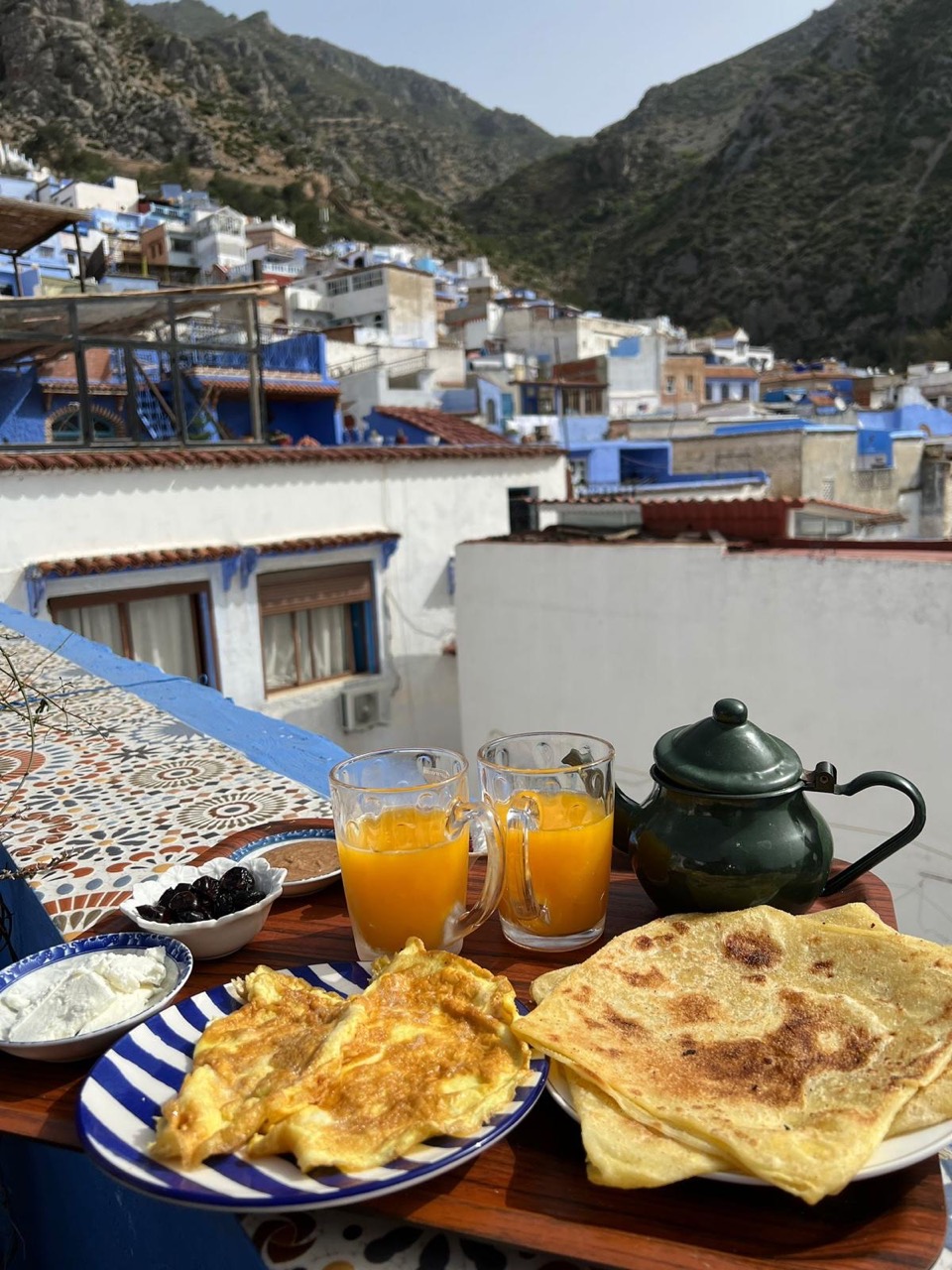
We found a charming little café called Triana, which I cannot recommend enough. For just $3-4 (30-40 MAD), we were treated to a delicious and plentiful spread of eggs cooked to perfection, fresh croissants that flaked at the touch, salty olives, and sweet, homemade jam.
But the real star of the show, the thing I still dream about, was the bread. It was a type of local flatbread, warm and soft, almost like a pancake, and I couldn’t get enough of it. I was literally stuffing my face with it, much to the amusement of my friends! The coffee was also, without a doubt, the best I had in Morocco.
Sitting there, on that sun-drenched rooftop, with the Blue City spread out before me like a map of dreams, I felt a profound sense of peace and contentment. It was a moment of pure travel bliss.
Late Morning: Explore the Medina Streets (10:30 AM – 12:00 PM)
Continue wandering through the medina’s narrow streets. Entry to the medina is free, but some locals may ask for a small tip (5-10 MAD) to pose in front of their beautifully decorated doorways.
Look out for the famous Sidi Bouchouka street with its wide blue stairs framed by colorful tiles and mosaics. This is one of the most photographed spots in Chefchaouen, so arrive early to avoid crowds.
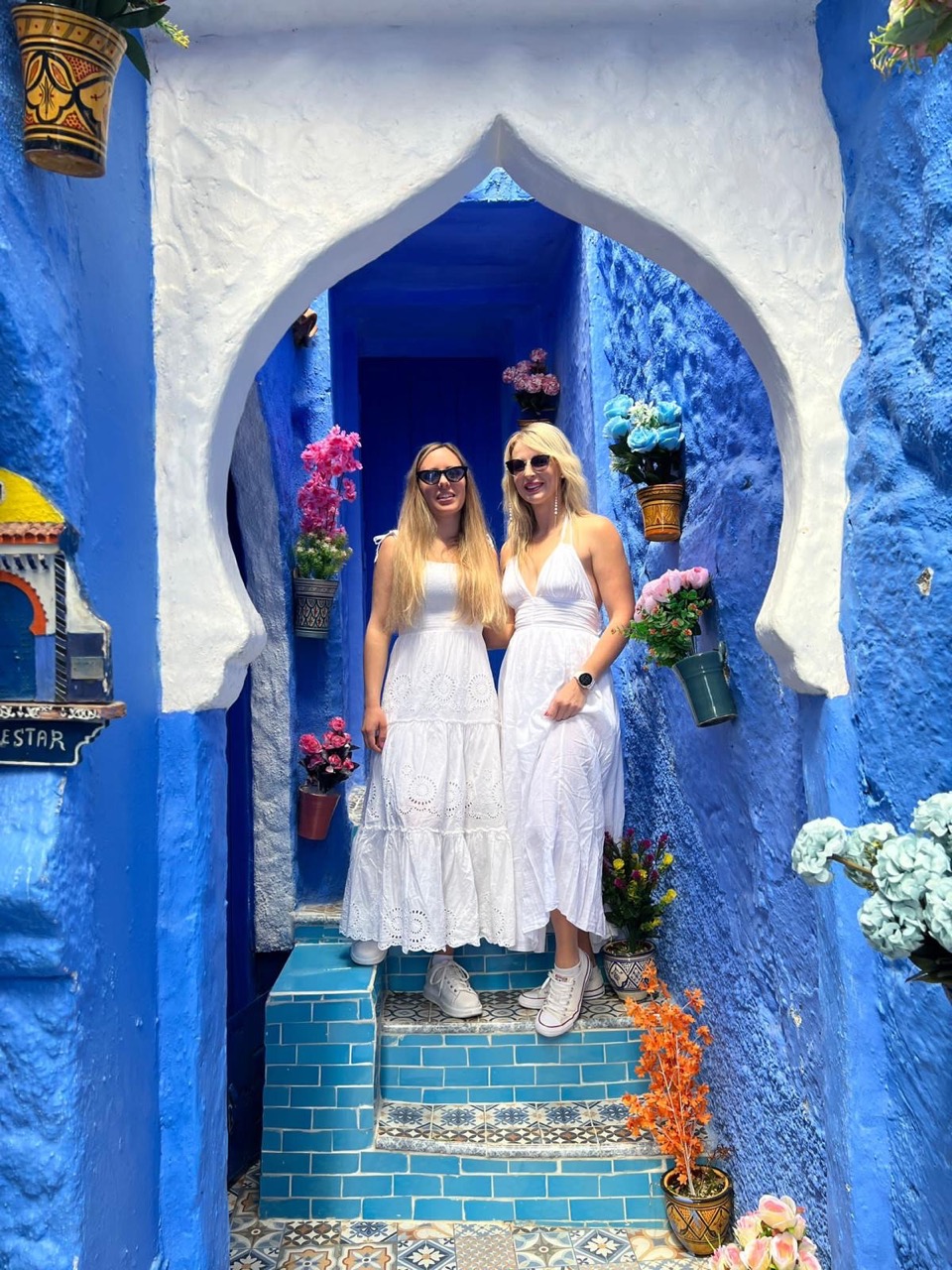
Lunchtime: A Taste of Traditional Morocco (12:00 – 2:00 PM)
For lunch, make your way to the bustling Uta el-Hammam Square, the vibrant heart of the medina. The square is a lively hub of activity, lined with restaurants and cafes, and it can be a bit overwhelming with all the vendors and restaurant hosts trying to lure you in.
Make a beeline for Morisco. Go straight to the rooftop terrace for a stunning, uninterrupted view of the grand Kasbah and the lively square below. The portions are generous, and the food is fresh, fragrant, and utterly delicious.
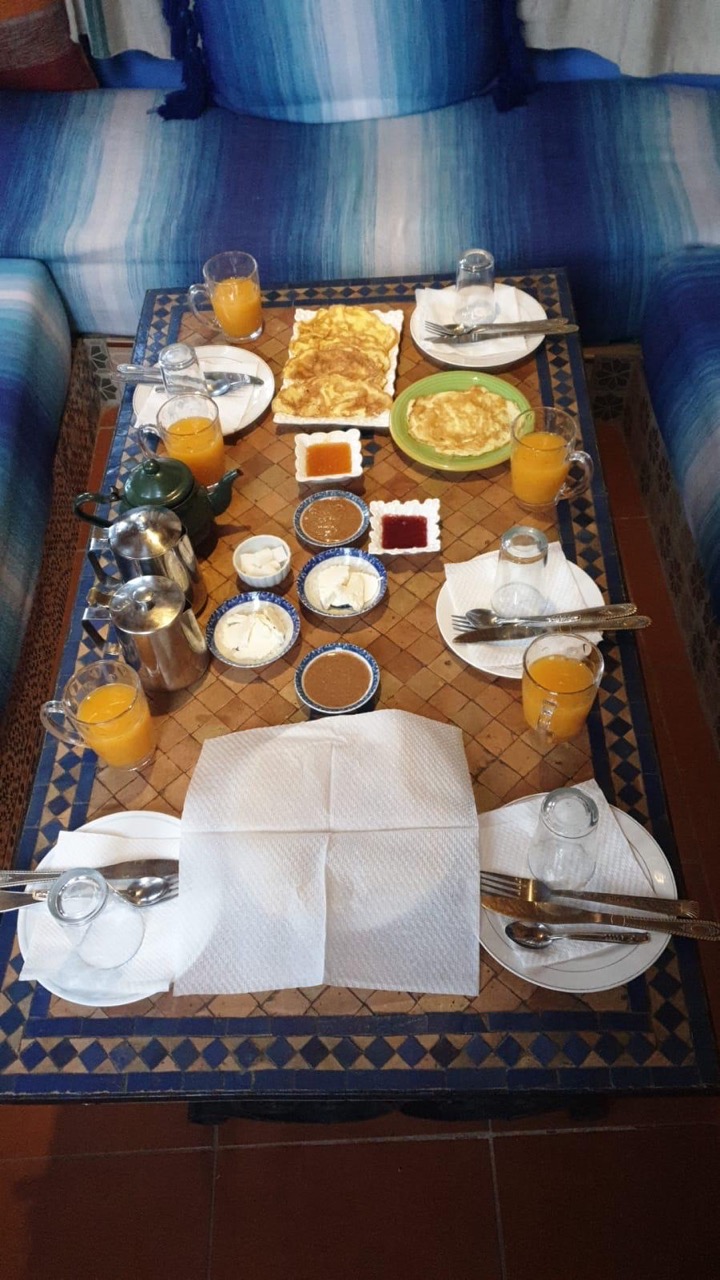
I ordered the beef tagine, and I can honestly say, without exaggeration, it was the best I had in all of Morocco. The meat was so tender it fell off the bone, and the sauce was a rich, aromatic blend of spices.
| Restaurant | Highlights | Price Range | Signature Dishes | Location |
|---|---|---|---|---|
| Triana | Best breakfast, upscale vibe, great terrace | $3–4 (30–40 MAD) | Breakfast sets, excellent coffee | Medina |
| Morisco | Generous portions, kasbah views | $8–12 (80–120 MAD) | Beef tagine, couscous | Uta el-Hammam Square |
| Bab Ssour | Best restaurant in Chefchaouen | $10–15 (100–150 MAD) | Traditional Moroccan cuisine | Medina |
| Cafe Clock | Popular among tourists | $6–10 (60–100 MAD) | Moroccan and international | Medina |
| Cafe Al Baraka | Budget-friendly local spot | $5 (50 MAD) | Half roast chicken with sides | Lower medina |
Afternoon: Explore the Kasbah Museum (2:00 – 3:30 PM)
After a satisfying lunch, it’s time to delve into the history of Chefchaouen at the Kasbah Museum. This impressive 15th-century fortress, located right in Uta el-Hammam Square, is a beautiful example of Andalusian architecture, with its imposing red-brown walls standing in stark contrast to the surrounding blue city.
Entrance fee: $6 (60 MAD) for foreigners, $1 (10 MAD) for Moroccans
Inside, you’ll find a surprisingly tranquil and beautiful garden, a former prison that offers a glimpse into the city’s past, and a small but informative ethnographic museum where you can learn about the history, culture, and traditional crafts of the region. It’s a great way to spend an hour or two, escaping the midday sun and immersing yourself in the city’s heritage.
Mid-Afternoon: Visit Ras al-Ma’ Spring (3:30 – 4:30 PM)
Take a short walk to Ras al-Ma’, a natural spring just outside the medina walls. This is where locals traditionally came to wash their clothes, and it’s a peaceful spot to cool off and dip your feet in the refreshing mountain water.
Entry: Free
There are small cafes here where you can enjoy fresh orange juice ($1-2 / 10-20 MAD) while listening to the soothing sound of flowing water.
Late Afternoon: Hike to the Spanish Mosque (4:30 – 6:30 PM)
As the afternoon sun begins to mellow and cast long, dramatic shadows over the city, it’s time for a short pilgrimage. The hike to the Spanish Mosque is an essential Chefchaouen experience.
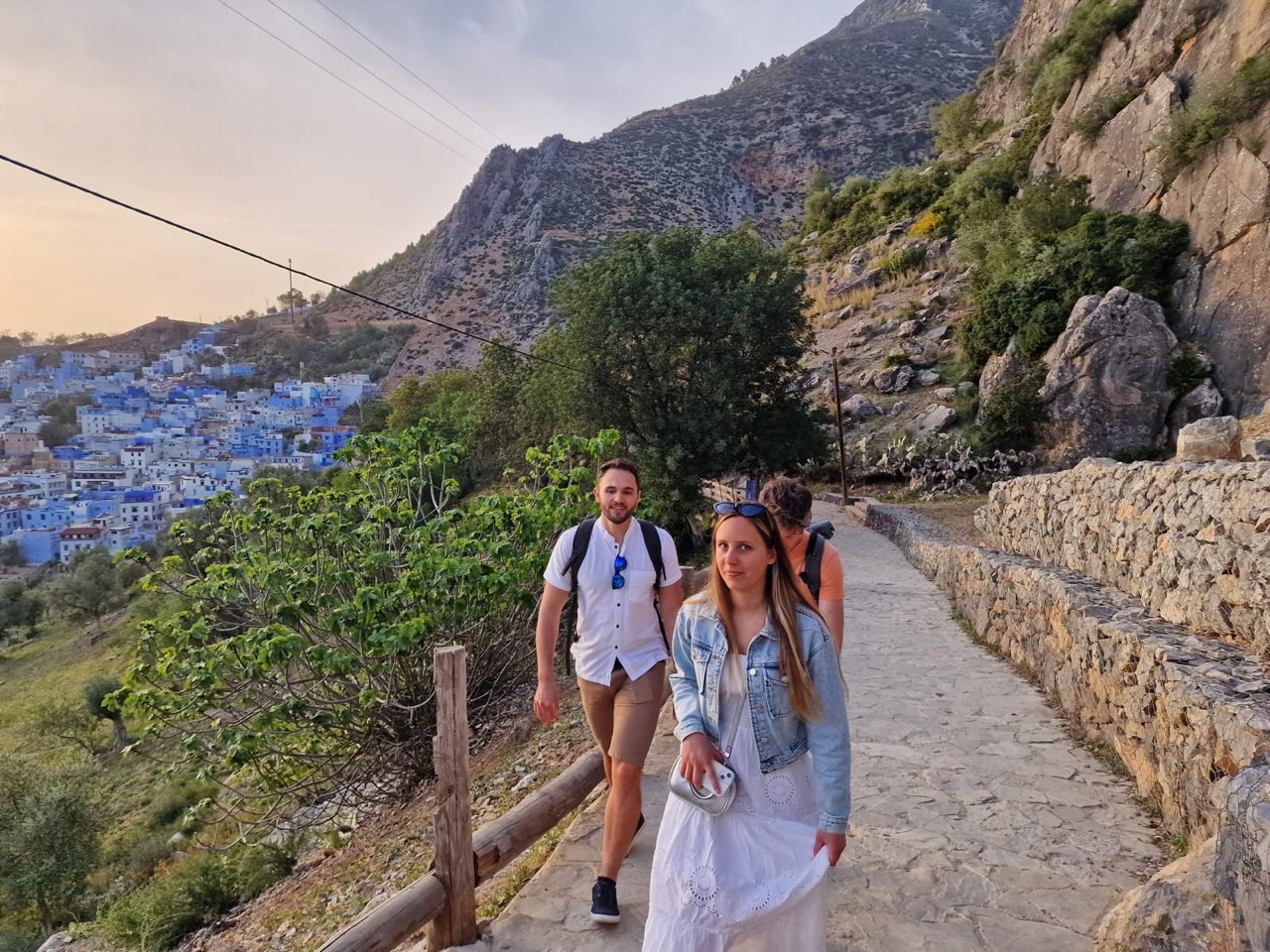
The mosque, which is called Mosque Jemma Bouzafar by the locals, was built in the 1920s during the Spanish colonial period. It sits on a hill overlooking the city, and the view from the top is nothing short of spectacular.
Hiking details:
- Distance: 1.5 km each way
- Duration: 30-45 minutes uphill
- Difficulty: Moderate (steady uphill climb)
- Cost: Free
- Best time: 1 hour before sunset
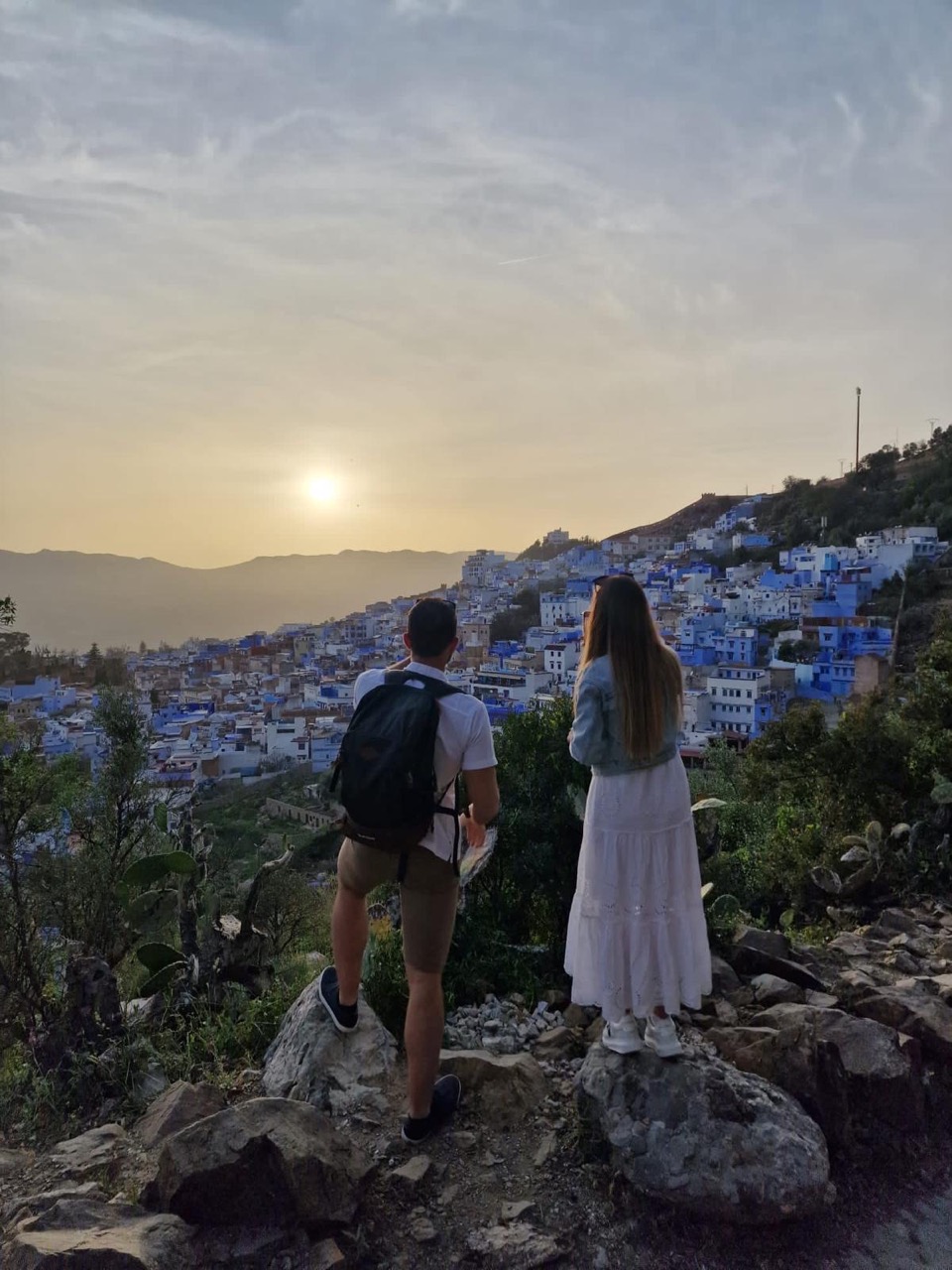
The hike itself is not too challenging, but it is a steady uphill climb, so be prepared for a bit of a workout. The trail starts at the Bab El Onsar gate, and it’s a paved path all the way to the top, making it easily accessible.
We took our time, stopping frequently to catch our breath and to take photos of the ever-expanding view. The view from the top was worth every single step. We found a spot on the hillside, along with a mix of other travelers and locals, and watched in silence as the sky transformed into a canvas of fiery oranges, soft pinks, and deep purples.
Evening: Dinner with a View (7:00 – 9:00 PM)
For your final meal in Chefchaouen, I recommend finding a restaurant with a rooftop terrace where you can enjoy a delicious meal under the stars, while watching the city light up at night.
We decided to venture off the beaten path and went to a place called Cafe Panorama Lopar, which is a bit of a hidden gem. It’s about a 45-minute hike from the medina, but the view and the experience are absolutely worth the effort.
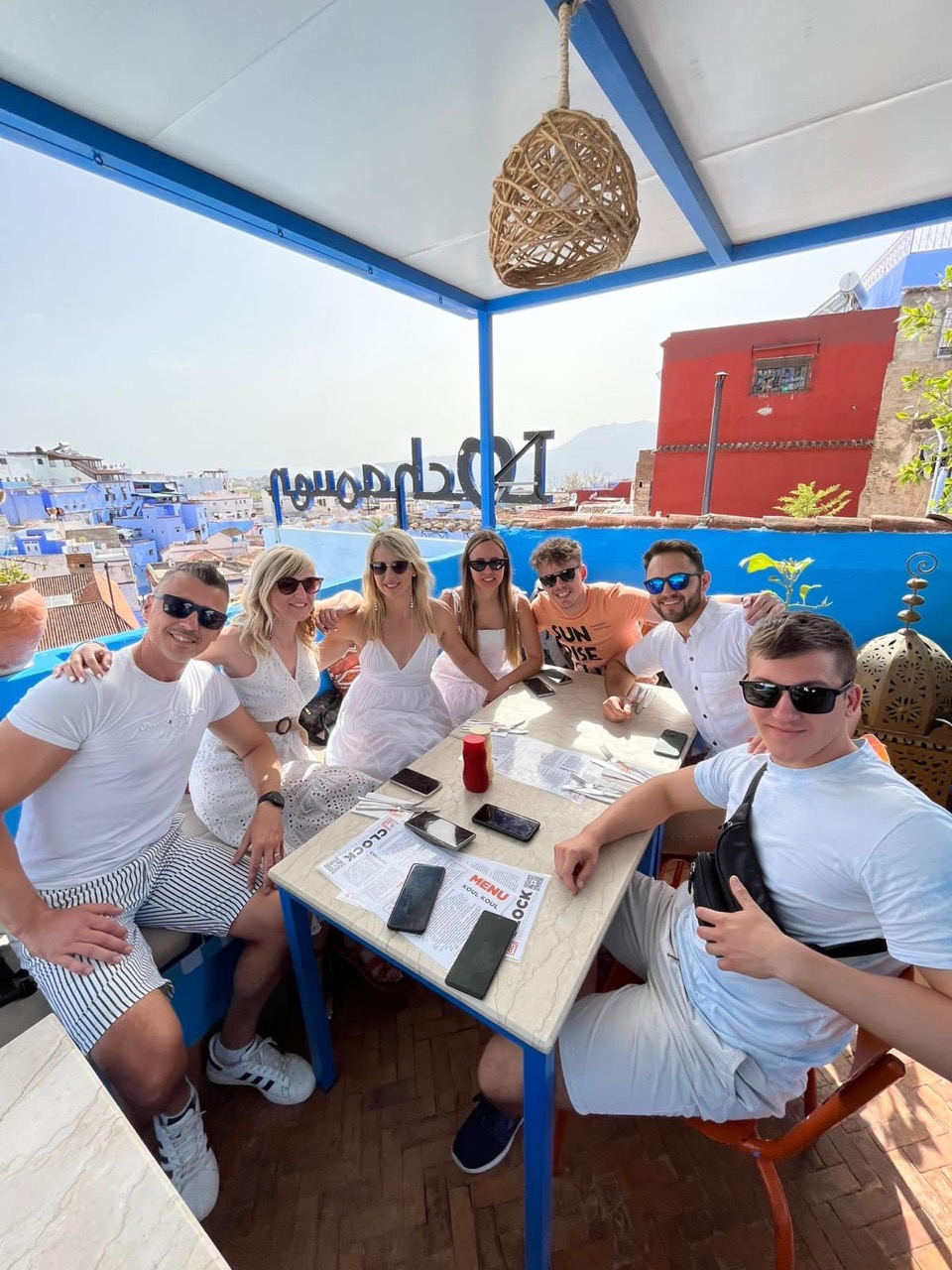
Price: $8-12 (80-120 MAD) for a complete meal
The restaurant is run by a lovely local family, and they serve the most delicious and authentic vegetarian and kefta tagines, cooked with love and served with a smile. It’s a truly authentic and intimate dining experience, a world away from the touristy restaurants in the main square.
What About the Local Souk?
If you happen to be in Chefchaouen on a Monday or Thursday, you’re in for a treat! These are the days when the local souk (market) takes place on the outskirts of the medina.
Entry: Free
It’s a vibrant, chaotic, and utterly fascinating scene. Vendors from the surrounding Rif Mountains come to the city to sell their wares, and you’ll find everything from fresh produce, fragrant spices, and local goat cheese (jben) to handmade leather goods, colorful carpets, and traditional djellabas.
Typical prices at the souk:
- Fresh goat cheese: $2-3 (20-30 MAD)
- Handmade leather bags: $10-20 (100-200 MAD)
- Traditional carpets: $30-100 (300-1000 MAD)
- Spices: $1-3 (10-30 MAD) per 100g
Practical Tips for Your Visit
What to Wear
- Comfortable walking shoes (essential for all the stairs!)
- White or light-colored clothing for the best photos
- Modest clothing that covers shoulders and knees
- Hat and sunglasses for sun protection
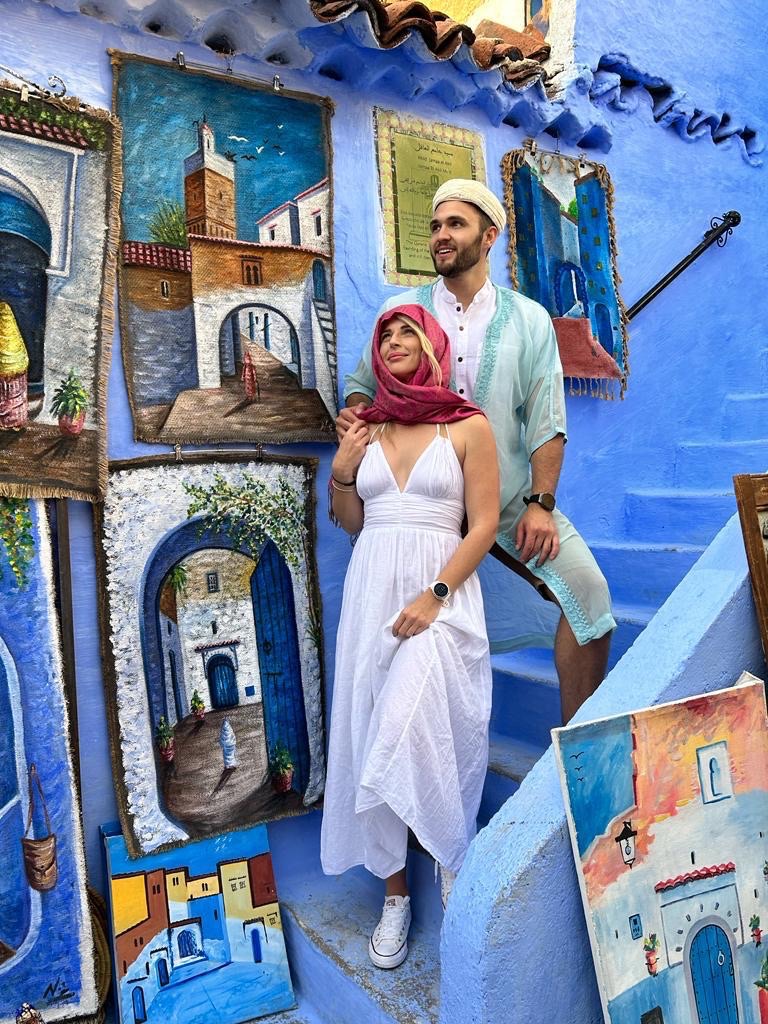
Photography Etiquette
- Ask permission before photographing people
- Some doorways charge 5-10 MAD for photos
- Early morning (7-8 AM) is best for crowd-free shots
- Be respectful of residents’ privacy
Budget Breakdown (Per Person)
- Breakfast: $3-4 (30-40 MAD)
- Lunch: $8-12 (80-120 MAD)
- Kasbah Museum: $6 (60 MAD)
- Drinks/snacks: $3-5 (30-50 MAD)
- Dinner: $8-12 (80-120 MAD)
- Total daily budget: $28-39 (280-390 MAD)
Transportation Costs
- From Marrakech: $33 (330 MAD) by bus (12-18 hours)
- From Tangier: $15 (150 MAD) by bus (5.5 hours)
- Private car with driver: $200-300 per day (negotiable)
A Final Word
Chefchaouen is a city that will capture your heart, your soul, and your imagination. It’s a place where you can truly get lost, in the best possible way, in a sea of blue. It’s a city where every corner is a work of art, where the people are as warm and welcoming as the Moroccan sun, and where even a simple washing machine hose can become a source of wonder.
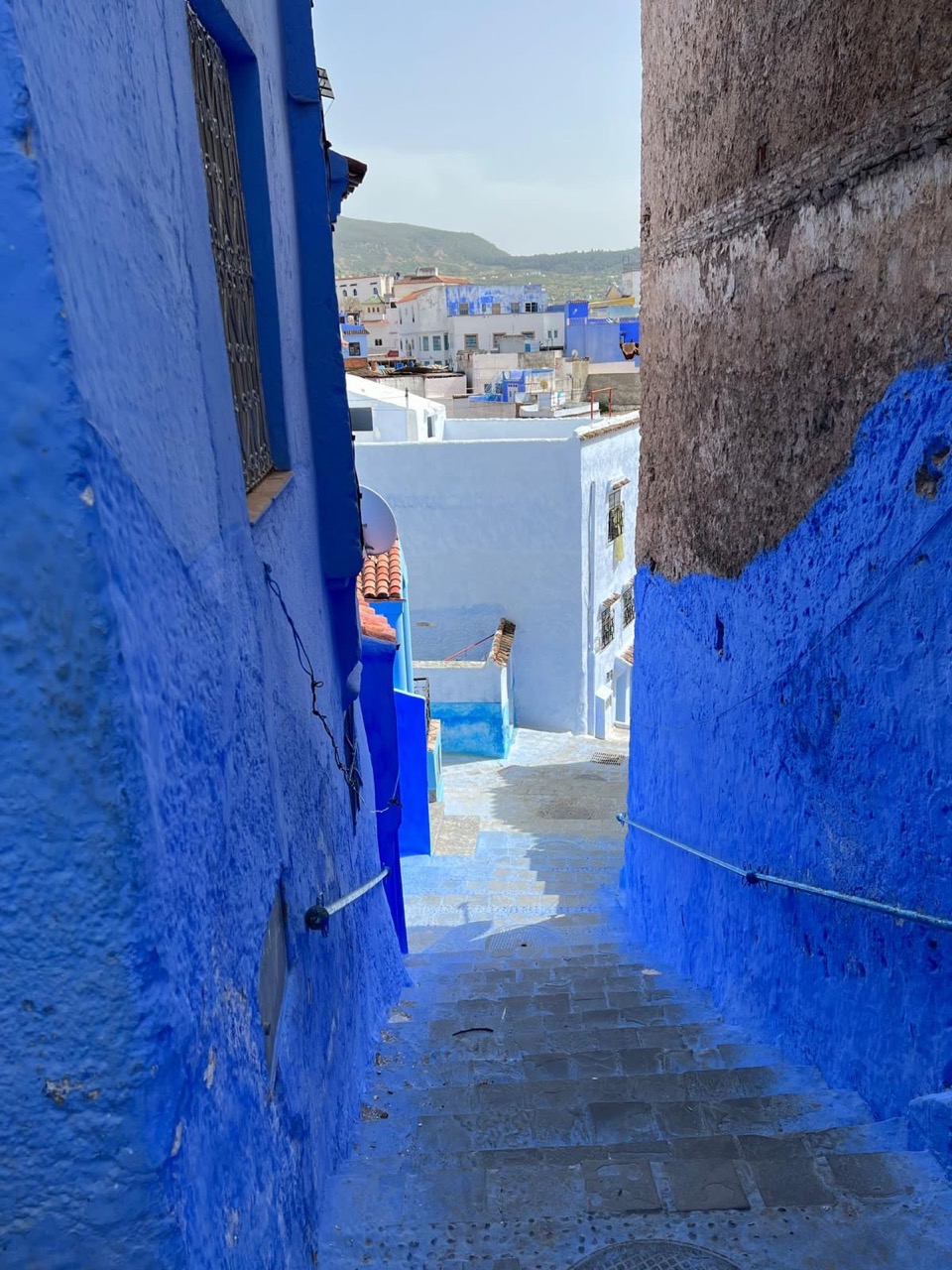
Yes, the journey to get there can be a long and arduous one, a true test of endurance. But as they say, the best things in life are worth waiting for, and the most rewarding journeys are often the most challenging. And Chefchaouen is definitely worth the wait, and the journey.
So, pack your bags, book your flight, and get ready for an adventure you’ll never forget. And if you find yourself on a long and winding road in the middle of Morocco, with hours of travel still ahead of you, just smile and remember my mantra: “Just three more hours!” You’ll get there eventually, and trust me, it will be more than worth it.

